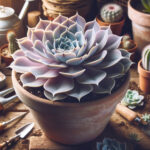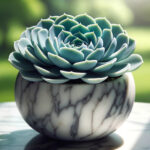If you’re a fan of all things succulent, you’re in the right place! We’re focusing on the Echeveria Pulidonis today. Bursting with personality, this little plant has charmed its way into greenhouses and windowsills around the world. But what exactly makes this species stand out? Let’s dig deeper (pun intended).
Meet the Echeveria Pulidonis!
Echeveria Pulidonis – sounds exotic, doesn’t it? Indeed, this succulent boasts a rather majestic name due to its rich Mexican heritage. Known to originate from the sandy, parched regions of Mexico, it has adapted splendidly to indoor living spaces offering it a niche against its other green counterparts.
The Echeveria Pulidonis’s Unforgettable Appearance
Ever spotted those adorable plants with plump, fleshy leaves arranged in a rosette pattern? That’s probably our star, the Echeveria Pulidonis. Its leaves tell a tale of endurance, climatically designed to retain water in the driest conditions. Their glossy texture, candy-apple green shade, with a hint of red at the edges is a spectacle that seems almost painted by an artist. No wonder they became such a popular succulent choice!
The Genus Echeveria and the Uniqueness of Pulidonis
Belonging to the era of early 18th-century botanists, the genus Echeveria houses around 150 species, all known for their resilience, compact size, and radiant color. Within this marvel of diversity, the Echeveria Pulidonis still manages to stand out. How so, you ask?
Not only is the Echeveria Pulidonis aesthetically pleasing, but it’s also a fuss-free plant. It’s easy to manage, survives neglect, and rewards you with cheery, year-round greens. The occasional springtime flowers are an added bonus! If you’re looking for a rewarding beginner’s plant or something to perk up your office desk, Echeveria Pulidonis is the one.
Echeveria Pulidonis: The Beauty in the Details
If one day, you joyfully stumble upon a lovely succulent with rosette features and wonder, “Wow, what’s this beauty’s name?” you might be looking an Echeveria Pulidonis in the eye. With its modest size, appealing color palette and stunning bloom, this succulent never fails to lure in plant-lovers.
Structure and Size
Let’s talk about the structure first. Typically, an Echeveria Pulidonis sports a spellbinding rosette structure, enticing plant admirers with its neat symmetrical pattern. It’s this pattern that makes it an eye-catching centerpiece in your succulent garden. Now, don’t get mistaken by thinking, this green beauty is a big fellow. She’s petite but far from insignificant! The Echeveria Pulidonis comfortably grows between a handy 4 to 5 inches in diameter, making it the perfect succulent to snugly fit into small spaces, grow in containers or even hang from a basket.
The Color Palette
But what about the “what does Echeveria Pulidonis look like?” query. The answer – it’s a mesmerizing blend of colors. Generally, the Echeveria Pulidonis breeds green apple colored leaves, but that’s not the end of the color story. The real vibrant game begins on the edges. The leaf margins are highlighted with a flush of vibrant red, gifting the entire plant a ravishing outline. A picture perfect, wouldn’t you say so?
Blooming Marvellous
And the scene doesn’t stop rolling there. Another intriguing attribute of Echeveria Pulidonis is its bloom. Wait for spring or summer to arrive, and you’ll witness a show-stopping display of red and yellow bell-shaped flowers on long stalks popping from the center of the rosette. This sudden blast of color adds an unexpected layer of beauty to the already attractive succulent, making Echeveria Pulidonis a blooming marvel in your garden or home.
When you get right down to it, whether it’s the perfectly compact rosette pattern, the stunning blend of colors, or the enthralling bloom, Echeveria Pulidonis brings joy and sparkles wherever it grows. One can’t help but admire the unique charm of this gorgeous succulent.
Let’s dive into the exciting world of Echeveria Pulidonis, a spectacular succulent that adds a splash of color to any room or garden. Its charm isn’t just in its aesthetic appeal. It’ll amaze you by its adaptability and resilience, thriving in conditions few plants can handle. Yet, to truly master the game and let your Echeveria Pulidonis flourish, you need to understand its growth requirements.
Understand the Light Requirements of Echeveria Pulidonis
Picture a bright, sunny day at a beach or in a desert. That’s the native habitat for Echeveria Pulidonis. As such, it absolutely adores bright but indirect sunlight. While you might be tempted to place it directly under the sun—more sunlight should be better, right?—you’d be doing more harm than good. Too much sunlight can scar your beautiful plant. The key here is balance. Give it around six hours of sunlight each day and your Echeveria Pulidonis will reward you with its stunning looks. Consider placing it near a sunny east or west-facing window if you’re growing it indoors.
The Ideal Temperature for Echeveria Pulidonis
The fascinating thing about Echeveria Pulidonis is its resilience. Originating from the warmer parts of Mexico, this succulent is used to fluctuating temperatures. During the day, it can withstand temperatures up to 80°F (27°C). At night, it can still thrive even when temperatures drop to as low as 40°F (4°C). However, while the toughness of Echeveria Pulidonis is certainly applause-worthy, remember it’s not invincible. Should temperatures dip below freezing, or soar too high in a heatwave, it would be wise to move your plant indoors or offer some form of protection.
Navigating the Route of Humidity with Echeveria Pulidonis
Your Echeveria Pulidonis isn’t a big fan of humidity. It loves to keep things dry and airy. If you live in a humid area, don’t worry! Just create a well-ventilated environment for your plant. For example, consider placing it in a room with an air conditioner or a dehumidifier. Humidity control can make all the difference for the health of your Echeveria Pulidonis.
Mastering the art of caring for Echeveria Pulidonis can seem tricky at first but with these tips on light, temperature, and humidity, you’re well on your way to becoming a pro. Keep in mind, it’s all about moderation and balance. Too much or too little of anything can stress your plant. Tuning into its needs will lead to a happy and thriving Echeveria Pulidonis.
Step-By-Step Guide to Planting Echeveria Pulidonis
Roll up your sleeves, grab your gloves and let’s get down to the nitty-gritty of how to plant your Echeveria Pulidonis. This isn’t just another plant; it’s a mesmerising succulent that calls for your green fingers. But fear not, we’re here to escort you through the process, one step at a time.
Preparing the Potting Soil
To kick things off, let’s first put our focus on your Echeveria Pulidonis’s crib — the potting soil. Soil preparation is key in planting succulents. I remember the time I tried to tote a shortcut, simply dumping my Echeveria into any old potting mix. Needless to say, it didn’t end well!
You’ll want to prepare a special blend of fast-draining soil to ensure your Echeveria Pulidonis thrives. A combination of cactus mix and perlite works like magic — I use a 2:1 ratio. Mixing these two creates a perfect blend which is porous enough to let water pass through and prevent any waterlogging.
Once you’ve mixed your soil, fill your chosen pot halfway. A shallow, wide pot works best for the Echeveria Pulidonis, as its roots tend to spread out rather than digging deep. But please ensure your pot has drainage holes – a water-clogged Echeveria is a sad sight to see.
Planting the Echeveria Pulidonis
Now, onto the main event: planting your Echeveria Pulidonis! This process always reminds me of that saying, “They may forget what you said, but they will never forget how you made them feel.” The way you handle your Echeveria during planting leaves a significant lasting impact on its growth.
Take your Echeveria Pulidonis, carefully inspecting its roots for any signs of rot; healthy roots should be a light color. Gently spread them out in the pot, sprinkling the fast-draining soil mix over them until the base of the Echeveria Pulidonis sits level with the top of the pot.
Here’s a personal tip: Always water lightly after planting. This gives your Echeveria Pulidonis a well-deserved sip after its relocation journey, and helps compact the soil. Remember, the first water could make or break your Echeveria’s survival chances, so go easy on the pour!
Now, sit back and watch your Echeveria Pulidonis bloom. Planting an Echeveria Pulidonis might seem like a daunting task at first, but with this guide, I have no doubt you will rise to the occasion. Good luck, green thumbed friends!
Watering and Feeding the Echeveria Pulidonis: A Simple Guide
If you’re wondering how often to water your Echeveria Pulidonis, you’re not alone. Many succulent lovers trip over this crucial detail. The truth is, there’s no one-size-fits-all schedule. You see, Echeveria Pulidonis has pretty specific watering needs that depend on a variety of factors, such as temperature and soil type. But don’t worry, once you learn the ropes, it becomes second nature.
Echeveria Pulidonis Watering Guidelines
Your Echeveria Pulidonis is a resilient succulent, but that doesn’t mean it should be drowned in H2O. It prefers the “soak and dry” method. This involves watering the plant thoroughly and then allowing the soil to dry out completely before the next watering. That’s right; your Echeveria Pulidonis loves playing hard to get!
Now, I bet you’re wondering, “how often should I do this?” The key is to monitor the soil. Once it’s bone dry, it’s time to water again. During the summer, this could mean watering your Echeveria Pulidonis once a week. But in cooler months, it might sip water as infrequently as once every three weeks.
Feeding Your Echeveria Pulidonis
Like a professional bodybuilder who needs his protein shakes, your Echeveria Pulidonis also needs its dose of nutrients to flourish. While it can survive without fertilizer, feeding your Echeveria Pulidonis can boost its growth and vibrant color. Now, you won’t need to make a gourmet meal, a simple balanced succulent fertilizer will do.
When it comes to timing, feeding your Echeveria Pulidonis is best done during its active growth season — typically spring and summer. Apply the succulent fertilizer about once a month during this period, and your Echeveria Pulidonis will reward you with lush, healthy growth.
Remember, over-fertilization can do more harm than good. It’s like forcing your Echeveria Pulidonis to eat a five-course meal when it’s already full. So, make sure to follow the product’s recommended dilution rates, and your Echeveria Pulidonis will be as happy as a clam.
Now that we’ve talked about how to nurse your Echeveria Pulidonis to its succulent perfection, we must address the unsightly issues that could hamper its splendor. As with all plants, these charismatic succulents can draw the unwanted attention of certain pests and diseases. Knowledge is power, and having a clear understanding of these common problems will help you keep your Echeveria Pulidonis looking its best.
Recognizing Echeveria Pulidonis Pest Problems
Just as honey attracts bees, the succulent leaves of Echeveria Pulidonis appeal to a variety of pests. The usual suspects include mealybugs, aphids, and spider mites. The sight of these miniature monsters isn’t pretty, and neither is the damage they inflict. They feed on the pulpy leaves, leaving behind discolored, wilted, or misshapen foliage. If you find yourself squinting at tiny white or green specks disturbing the beautiful symmetry of your Echeveria Pulidonis, you likely have a pest problem on your hands.
Combatting Pests on your Echeveria Pulidonis
Prevention is always the best route to take. Regularly inspect your Echeveria Pulidonis for signs of invaders. Establishing this routine check will help you catch any pests before they transform from a minor inconvenience to a major issue. In the unfortunate event of an infestation, fear not. A mild insecticide or a homemade concoction of soap and water sprayed directly onto the problematic pests can bring your Echeveria Pulidonis back to its prime in no time.
Identifying Common Diseases of the Echeveria Pulidonis
Regrettably, pests aren’t the only worries for your Echeveria Pulidonis. Various diseases, often linked to fungal infections, can pose a threat as well. Root rot is arguably the most common, a fearsome foe often initiated by overwatering. When your succulent’s roots turn black and feel mushy instead of firm, root rot could be the culprit. Other common diseases include powdery mildew, which leaves a white, powdery substance on the foliage, and leaf spot, characterized by dark, discolored patches on the plant’s leaves.
Protecting your Echeveria Pulidonis from Diseases
Navigating through diseases can be tricky, but here again knowledge is your lifesaver. Taking preventative measures such as providing well-draining soil and avoiding overwatering will strengthen your defense against root rot. For other diseases like powdery mildew or leaf spot, the key is to maintain good air circulation around your Echeveria Pulidonis and keep the foliage dry as much as possible. And if you do spot a disease, take immediate action to prevent its spread. This could mean applying a fungicide or pruning away the affected parts.
In conclusion, growing a healthy Echeveria Pulidonis does require constant vigilance against pests and diseases. But with the right knowledge and a bit of dedication, these hurdles are anything but insurmountable. You’ve got this!
Propagating Echeveria Pulidonis: A Comprehensive Guide
Nothing beats the rush of seeing your Echeveria Pulidonis sprout new life! And as I like to say, those who propagate together, stay together! Let’s explore the wonderful world of propagating these little succulent gems – whether it be from leaves, cuttings or seeds.
The Magic of Leaf Propagation
Believe it or not, a single leaf from your Echeveria Pulidonis can be the start of a whole new succulent! Here’s how you achieve this little bit of gardening sorcery: Begin by gently prying the leaf from the stem. Make sure you get the whole leaf, no breakage, as it won’t propagate if it’s damaged.
Now comes the time for patience. Place your leaf, calloused-end down, on well-draining soil. Resist the urge to water it for a while, letting the leaf roots do their magic, stretching out and finding their way. After a few weeks, you will start seeing tiny rosettes sprouting! Congrats! You’re officially an Echeveria Pulidonis propagator.
Echeveria Pulidonis: Propagate Like A Pro With Cuttings
Leaf propagation is amazing, but using cuttings from the Echeveria Pulidonis can speed up the process. Here’s how: Take a sharp, clean knife and cut a piece of your succulent off, including a part of the stem. Just like before, patience is key. Let it sit for a few days so the “wound” can heal and form a callus.
Once that’s done, push the end of the cutting into a pot filled with well-draining soil. Take extra care not to water it right away. Wait until you see new growth sprouting from the top of the Echeveria Pulidonis before starting to water. Viola! Quaternion the gardener strikes again!
Seeding Your Succulent Success
Propagating Echeveria Pulidonis from seeds can be a slow but rewarding process. To start, sow seeds on the surface of well-drained soil. Don’t cover them; they need light to germinate. Keep the container in a warm, bright spot, out of direct sunlight. Remember to keep the soil slightly moist (but not waterlogged).
Give it time and before you know it, you’ll have Echeveria Pulidonis popping up all over the place! Another crown in your propagation kingdom.
Whether you prefer the leaf, cutting, or seeding method, propagating Echeveria Pulidonis is always an exciting challenge. So, go on, flex your green fingers and grow your own succulent army!
Understanding Echeveria Pulidonis and Its Unique Traits
When it comes to the vibrant world of succulents, nothing stands out quite like the echeveria pulidonis. Popular among green thumbs and novice plant owners alike, this special species of Echeveria holds its own against other commonly known types in the same family. But what exactly sets the pulidonis apart? Let’s delve into a comparative analysis and uncover the unique characteristics that make this succulent truly one-of-a-kind.
Unravelling the Unique Prowess of Echeveria Pulidonis
Right off the bat, one of the most noticeable features of the echeveria pulidonis is its strikingly beautiful aesthetic. Unlike its other Echeveria counterparts, pulidonis boasts a stunning emerald green color. Couple this with its edgy, red-tipped leaves, and you’ve got a succulent that takes home the crown in the beauty department!
Size and Shape: Where Pulidonis Shines
While most Echeveria species grow in a classic rosette form, the pulidonis sets itself apart with a compact, tightly wound formation. This means that your pulidonis will take up less space and offer a cleaner geometrical shape in your garden or pot – a definite win if you’re going for a minimalist look!
The Challenge of Sunlight
Here’s where things get a little tricky. The Echeveria pulidonis tends to be a bit particular about sunlight compared to other species. While it certainly loves a good bask in the sun, remember – too much of a good thing can also be harmful! Pulidonis has been known to develop sunburn if exposed to harsh, direct sunlight for prolonged periods. This is where it differs from other kinds, like the Echeveria elegans, which revel in relentless sun exposure.
Temperature and Watering
Now you might think, given its love for the sun, the echeveria pulidonis prefers warmer temperatures. Not quite right! Unlike the other desert-dwelling Echeveria species, pulidonis actually prefers cooler climates. And when it comes to watering, forget the rules you know about other succulents. Pulidonis boasts a unique ‘drink and dry’ preference – it enjoys a good soak once the soil has completely dried out.
So– in the face-off between echeveria pulidonis and other commonly-known Echeveria species, it’s clear that the pulidonis is a unique gem with its own set of needs and characteristics. Both a beauty and a challenge – this succulent surely commands a special spot in every plant enthusiast’s collection!
Frequently Asked Questions About Echeveria Pulidonis
You’ve been struck by the striking beauty of Echeveria Pulidonis, haven’t you? As a proud owner or prospective gardener of this succulent, you’re bound to have tons of questions. So, let’s dive in, shall we?
Is Echeveria Pulidonis Poisonous to Dogs?
Here’s a common concern. You’ve got a furry buddy at home and absolutely do not want your green hobbies to harm them. Luckily, Echeveria Pulidonis isn’t as wicked as it is beautiful. These succulents are generally considered non-toxic. So, your dogs and the pulidonis can coexist peacefully. But, remember to watch out for signs of trouble, because every dog is different, just like us humans!
How Often Should I Water My Echeveria Pulidonis?
Words of wisdom – under watering is better than over watering! Let’s picture it like this – you are at your favorite ice-cream parlor. While a scoop or two tastes divine, several scoops later you’re struggling. Same goes for our leafy pals. Echeveria Pulidonis loves a good soak but let it dry out completely before the next watering session. Depending on where it’s growing and what time of the year it is, watering once every 1-2 weeks works wonders.
How Much Sunlight Does Echeveria Pulidonis Need?
Imagine yourself chilling at the beach, relishing the sunlight, but absolute exposure for the entire day? No, thank you! Echeveria Pulidonis, too, loves sunlight but not in excess. Too much direct sunlight and it might get a sunburn. A few hours of morning sun followed by bright, indirect sunlight for the rest of the day suits this succulent well.
How To Propagate Echeveria Pulidonis?
Thrilled with your first Echeveria Pulidonis and want more to jazz up your space? No worries! Propagating this beauty isn’t rocket science. All it needs is a healthy leaf, a bit of patience, and voila! You’ll have a bunch of Echeveria Pulidonis sprouting around in no time. Nurture the mother leaf until it gives birth to tiny rosettes, and you’re all set!
Having your queries sorted makes caring for your Echeveria Pulidonis a joyful journey, doesn’t it?



